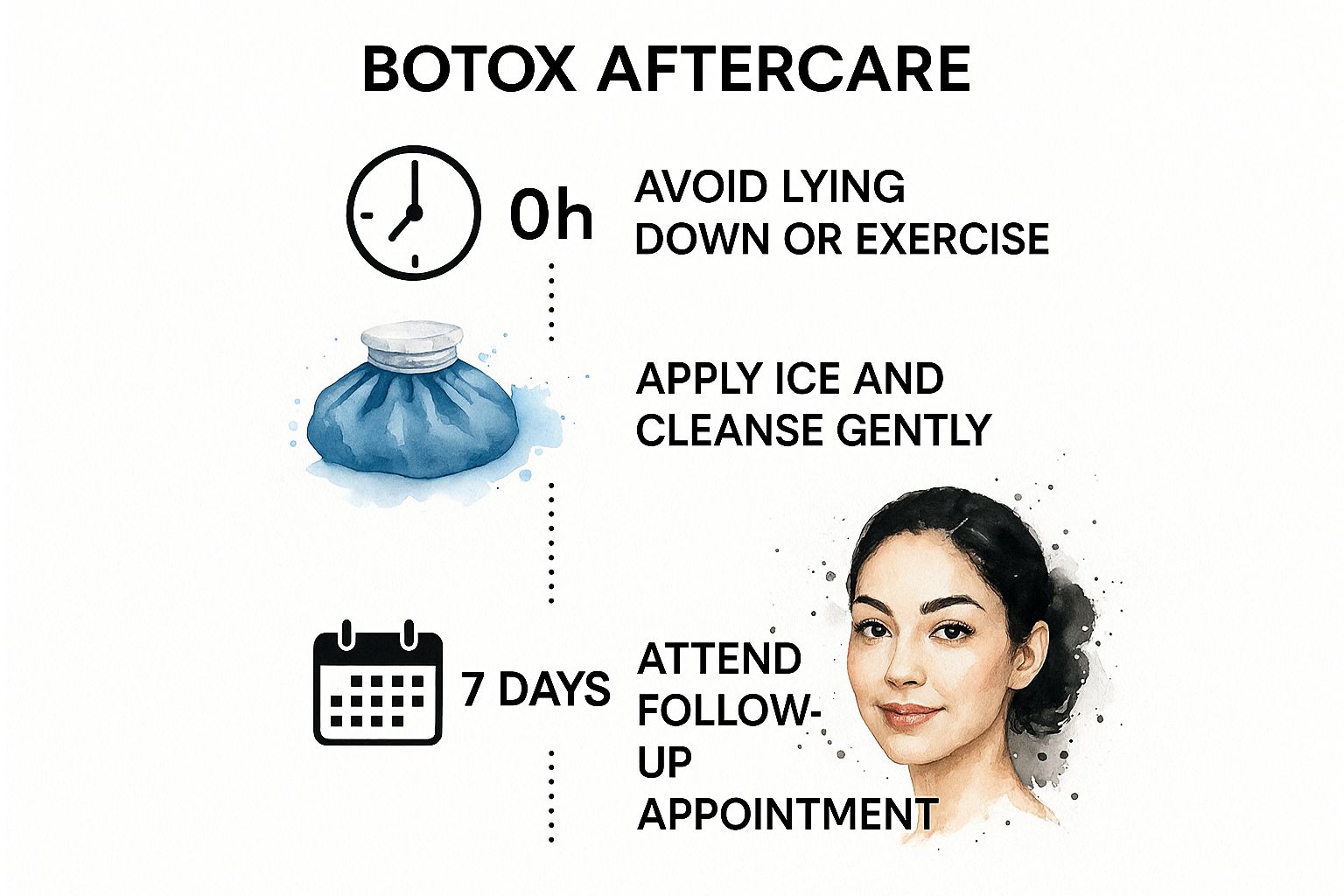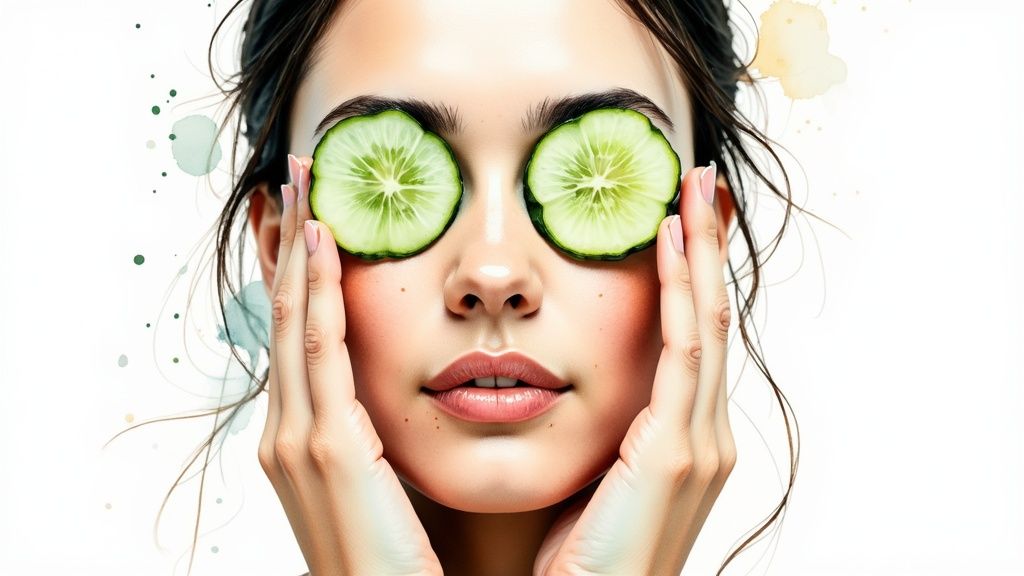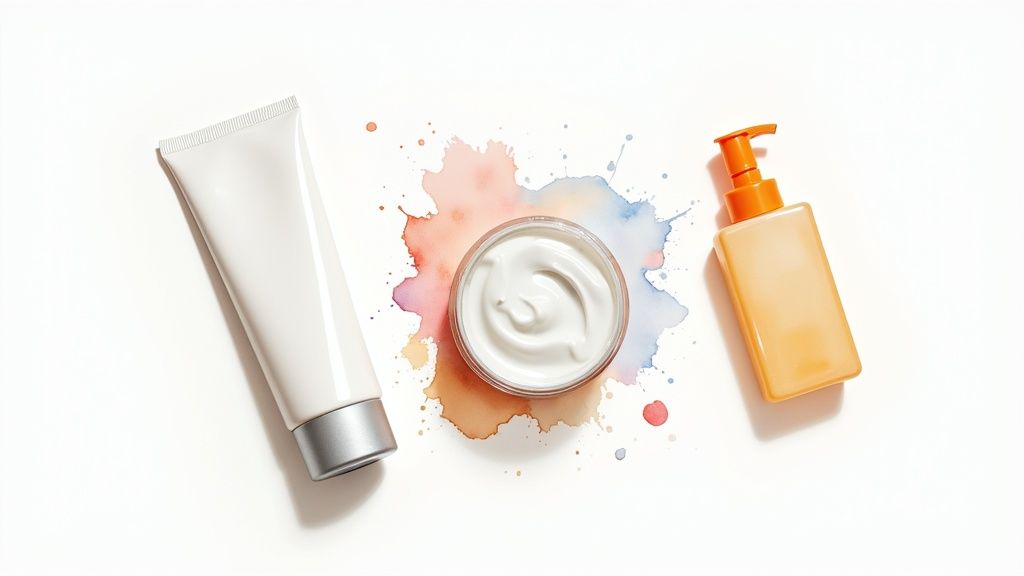Your Essential Botox Aftercare Guide
- Charis Aesthetics
- Jul 19
- 10 min read
The first few hours after your Botox treatment are absolutely crucial. This is the window where the product settles, and your actions directly influence how well it works and the final look you achieve.
Honestly, the most important rule for immediate Botox aftercare is a simple one: stay upright for at least four to six hours. Just as important is avoiding any strenuous activity during this time. Think of it as your best defence against the Botox migrating to unintended areas.
Your Immediate Post-Botox Recovery Plan
So, you've just left the clinic feeling excited about your results. What you do next really matters in protecting that investment. This isn't just about ticking boxes on a list of rules; it's about understanding why these steps are so important for getting that smooth, natural-looking outcome we're all after.
For instance, think about simple, everyday movements. Bending down to tie your shoes, leaning over to load the dishwasher, or even just lying down for a quick nap—all these things can cause gravity to pull the freshly injected product downwards. This is exactly how unwanted side effects like a droopy eyelid or an asymmetrical result can happen.
This infographic gives you a great visual guide for navigating that first week.

As you can see, the most restrictive period is right after your appointment, with the guidelines relaxing significantly over the first day and into the week.
The First Few Hours
The main goal right now is to let the Botox settle in peace. This means keeping your head level and avoiding anything that puts pressure on the treated areas. Even something as seemingly harmless as wearing a tight baseball cap, headband, or heavy glasses should be avoided for the rest of the day.
Your main job immediately after treatment is to simply be still and stay upright. Let the product do its work undisturbed to prevent it from moving to muscles it wasn't intended for.
Following aftercare properly makes a huge difference in minimising risks. We know from experience and studies that minor side effects like mild headaches or bruising at the injection sites can affect around 10% to 15% of patients, and this often happens when aftercare is overlooked.
That’s why practitioners across the UK are so insistent about avoiding lying down or bending over for those first four to six hours—it really does reduce these risks and support the treatment's effectiveness. For more insight into cosmetic procedure safety and trends, the British Association of Aesthetic Plastic Surgeons is an excellent resource.
By confidently navigating this initial period, you're setting yourself up for fantastic, lasting results.
Botox Aftercare Timeline The First 48 Hours
To make things even clearer, here’s a quick-reference timeline for what to do (and what not to do) in the first couple of days. Think of it as your cheat sheet for a smooth recovery.
Timeframe | What to Do | What to Avoid |
|---|---|---|
First 4 Hours | Stay upright. Gently exercise facial muscles (e.g., frowning, smiling). | Lying down, bending over, rubbing the treated areas. |
4-6 Hours | Continue to stay upright. You can have a light snack. | Strenuous exercise, alcohol, wearing tight headwear. |
First 24 Hours | Keep activity light. Sleep on your back if possible. | Hot showers, saunas, sunbeds, facials, massages. |
24-48 Hours | You can resume most normal activities. Be gentle with your skin. | Heavy workouts, excessive sun exposure, other skin treatments. |
Remember, this timeline is a guide. Following it closely helps ensure the Botox stays exactly where it was placed, giving you the best possible outcome from your treatment.
What to Avoid in the First 24 Hours

The first day after your treatment is all about giving your Botox the best possible chance to settle in and work its magic. Think of this 24-hour window as a crucial settling-in period. To get those flawless results, you’ll need to put a few activities on hold to ensure the product stays exactly where I’ve placed it.
One of the biggest pieces of Botox aftercare advice I give my clients is to postpone any strenuous physical activity. That high-intensity workout, your favourite spin class, or even a hot yoga session will have to wait for at least one full day.
Why is this so important? Intense exercise gets your blood pumping, and that includes to your face. This surge in circulation can potentially dilute the Botox before it has fully bonded to the muscle receptors, which could weaken its effect.
Keep Cool and Carry On
On a similar note, it’s a good idea to steer clear of extreme heat. Your post-treatment time is not the moment for saunas, steam rooms, or lingering in a hot shower. Heat also ramps up blood flow which, just like exercise, can interfere with the settling process and might even make any potential bruising a little worse.
This advice extends to your skincare routine as well. For the first day, please avoid using facial scrubs, exfoliating brushes, or any harsh cleansing tools. These can all apply unwanted pressure to the treated areas. A gentle cleanse is absolutely fine, but anything more vigorous should be paused.
The golden rule for the first 24 hours is to avoid anything that causes excessive heat, pressure, or blood flow to the face. This simple precaution helps protect your investment and prevent complications.
A Note on Alcohol and Bruising
It’s also best to skip happy hour for the evening. Alcohol is a known blood thinner, which can increase your chances of developing little bruises at the injection sites. This is a standard recommendation across the UK aesthetics industry, where proper aftercare is (rightly) seen as essential.
Bad aftercare, like drinking alcohol or exercising too soon, can heighten the risk of side effects like swelling or bruising, which may affect around 10–15% of people. You can learn more about UK aesthetics industry safety statistics at Policybee.co.uk. By making these small, temporary adjustments, you're setting yourself up for a smooth recovery and fantastic results.
Long-Term Strategies to Maximise Your Results

The first few days after your treatment are important, but it's the habits you build over the following weeks and months that really protect your investment. Think of your Botox as the first step; your daily lifestyle choices are what will keep you looking refreshed for the long haul.
Your most powerful tool for this is a solid skincare routine. It doesn't need to be complicated, but there's one non-negotiable: daily sun protection. Applying a broad-spectrum SPF of 30 or higher every single morning is your number one defence against the UV rays that accelerate ageing.
Sun exposure is notorious for breaking down collagen and elastin—the very proteins that keep your skin firm and youthful. Shielding your skin from the sun not only helps your Botox last longer but also maintains your skin's overall health. For a deeper dive, you can explore more of my expert tips on how to make Botox last longer in our detailed guide.
Reintroducing Other Treatments
A common question I get from clients is when they can safely resume other aesthetic treatments. It’s absolutely vital to give the Botox enough time to settle before you introduce anything that might interfere with it. A good rule of thumb is to simply wait.
Here’s a quick breakdown:
Facials and Peels: You’ll want to hold off on professional facials, chemical peels, or microdermabrasion for at least two weeks. This ensures there's no accidental manipulation or pressure on the freshly treated muscles.
Laser Treatments: The same goes for energy-based treatments like lasers or IPL. Postpone these for a minimum of two weeks to avoid any potential issues.
A proactive approach to your follow-up appointments is a game-changer. By scheduling your next session just before your results have completely worn off, you maintain a consistently natural and refreshed look, avoiding that "overdone" appearance.
This kind of strategic timing is key for seamless maintenance. When you plan ahead, you and your practitioner can work together to keep those muscles relaxed, preventing deep-set lines from ever fully re-forming. It's an approach that delivers better long-term value and keeps your results looking subtle and sophisticated.
Navigating and Managing Potential Side Effects
While Botox is an incredibly safe procedure, knowing what to expect afterwards gives you real peace of mind. Let’s be honest, even minor side effects can feel a bit worrying if you’re not prepared. The good news is that most reactions are very mild, temporary, and a completely normal part of the process.
You might notice a little bit of bruising, some slight swelling, or even a mild headache. This is usually just your body’s response to the tiny injections, and it almost always clears up on its own within a day or two. But remember, you’re never alone in this. Your practitioner is your partner in this journey, so never feel hesitant to get in touch if something feels off.
Handling Common Minor Reactions
If you do spot a bit of swelling or bruising around the injection sites, a simple cold compress is your best friend. The trick is using it correctly to get the benefits without interfering with your results.
Wrap it up: Never put ice or a cold pack directly onto your skin. Always wrap it in a clean tea towel or a soft cloth first.
Be gentle: Rest the compress lightly on the area for about 10 minutes at a time.
No pressure: This is the most important part—don’t press down. You want to cool the skin, not push the freshly placed Botox around.
A mild headache can sometimes pop up, especially if it’s your first time. If that happens, paracetamol is generally fine to take. It's a good idea to steer clear of anti-inflammatory painkillers like ibuprofen for the first 24 hours, as they can thin the blood slightly and increase the risk of bruising. It’s also worth knowing that other treatments can have similar effects; for instance, you can learn more by reading about the key risks of nose fillers in another one of our guides.
Peace of mind comes from knowing the difference between a normal, passing reaction and a rare warning sign. Temporary bruising or a slight headache is common; anything more persistent or concerning warrants a call to your practitioner.
When You Should Contact Your Practitioner
Serious side effects from Botox are very rare, but it's crucial to recognise the signs that need a professional eye. You should get in touch with your practitioner straight away if you experience any of the following:
Asymmetry: Things like a drooping eyelid or uneven eyebrows that develop a few days after your appointment.
Vision problems: Any kind of blurred or double vision.
Difficulty swallowing or speaking.
Allergic reaction: This could show up as hives, significant swelling away from the injection sites, or any trouble breathing.
Again, these situations are highly uncommon, but they highlight just how important it is to choose a medically qualified and experienced practitioner. Your safety should always be the number one priority.
Choosing a Safe Practitioner in the UK

When you're considering Botox, the product in the syringe is only half the story. The person holding it is just as important—if not more so. Your choice of practitioner is the single most critical decision you’ll make, and it directly affects not just your results, but your safety and Botox aftercare, too.
Here in the UK, the aesthetics industry is surprisingly unregulated when it comes to treatments for adults. This puts the responsibility firmly on your shoulders to do your homework and make sure the person you trust has the right qualifications. This is even more vital given the rise in popularity of these treatments among younger people.
In fact, a recent report revealed that 19% of UK individuals aged 18 to 25 have had procedures like Botox or fillers. This trend is a major red flag for medical professionals because, legally, almost anyone can perform these injections on adults without mandatory qualifications. This can easily lead to poor aftercare and serious complications. You can read more about these concerns around young people and cosmetic procedures on itv.com.
What To Look For In a Practitioner
When you’re vetting a potential clinic or injector, there are a few non-negotiable credentials you should always confirm. A safe, reputable practitioner will be proud of their qualifications and happy to share them.
A Medical Background: Always look for a registered nurse, doctor, dentist, or prescribing pharmacist. These professionals have a deep, clinical understanding of facial anatomy and medicine that is essential for safe practice.
Specialised Training: On top of their medical degree, they should have specific, certified training in aesthetic procedures and hold full insurance. Don't be afraid to ask to see their certificates.
A Thorough Consultation: A great practitioner will insist on a detailed consultation. This is their chance to understand your goals, review your medical history, and explain the procedure, its risks, and the aftercare involved. It’s also your chance to get a feel for them.
A true sign of an excellent practitioner is their focus on safety and suitability. They should be willing to say "no" if a treatment isn't right for you, prioritising your wellbeing over simply making a sale.
Understanding what the procedure involves is a key part of making a smart decision. For a complete overview, check out our guide to anti-wrinkle injections in the UK. Taking the time to get informed ensures you end up in safe, capable hands.
Your Botox Aftercare Questions Answered
It's completely normal to have a few questions swirling around after your Botox appointment. Even with the best preparation, real-life queries pop up. We get it. Here are the most common things clients ask us, with straightforward answers to help you navigate the next few days with complete confidence.
When Can I Wear Makeup After Botox?
It’s always best to give your skin a little breathing room. We strongly advise waiting at least four to six hours before applying any makeup. This short break allows those tiny injection points to fully close, which is key to preventing any unwanted bacteria from getting in and causing an infection.
When you do apply it later in the day, think ‘press, don’t pull’. Use a very gentle dabbing or patting motion with your sponge or brush. For the first 24 hours, it’s really important to avoid rubbing or tugging at the treated areas to make sure the Botox settles exactly where we want it.
Is a Mild Headache Normal After Treatment?
Yes, a slight headache is quite a common and temporary side effect. We see it most often in first-time clients or when treating the forehead area. Don't worry, it almost always fades within 24 to 48 hours.
If you need some relief, paracetamol is a perfectly safe option. We do recommend steering clear of anti-inflammatory painkillers like ibuprofen for the first day, though, as they can sometimes make you more prone to minor bruising.
How Soon Will I See Results?
This is where a little patience really pays off. You might start to notice the first hints of smoothness in just three to five days, but the final, beautifully refreshed result won't fully appear for about two weeks. It takes this long for the product to completely relax the muscles we've targeted.
On average, you can expect your fantastic results to last for three to four months. The secret to maintaining a seamless, natural look is to book your next appointment just as you start to notice movement returning.
Is It Safe to Fly After My Appointment?
This is a great question and one we hear all the time. The advice is simple: try to wait 24 to 48 hours before hopping on a plane. While the risk is generally low, the big change in cabin pressure during a flight could potentially make any minor swelling or bruising a little worse.
Giving it a day or two is just an easy precaution. It helps ensure your Botox settles perfectly and protects the beautiful results you're waiting for.
At Charis Aesthetics, we believe that exceptional results are built on a partnership of expert care and clear, honest guidance. If you're ready to see how our science-backed treatments can enhance your natural beauty, book your consultation with us today.


